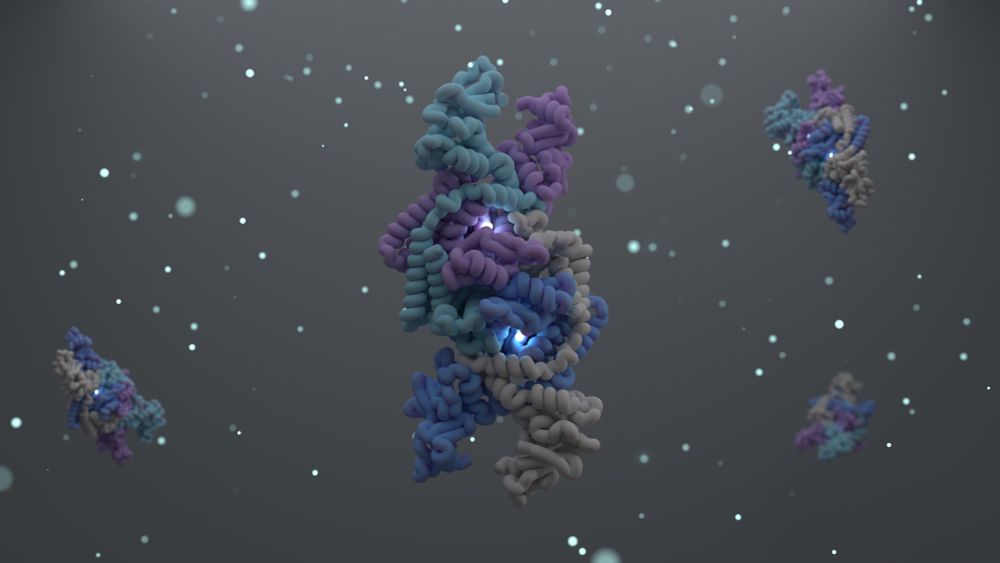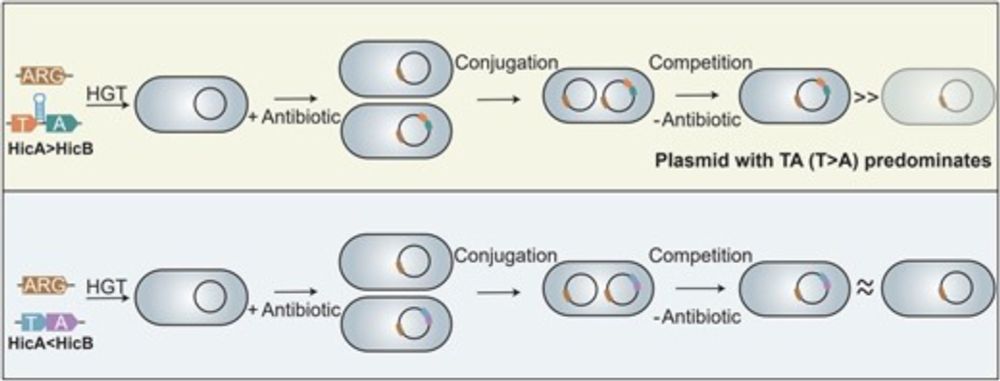Uracil first shown 2009 to be a QS signal in P. a. & UMP path important for QS & virulence. Moreover, 5-fluorouracil is a potent QS quencher & is the first QQ compound used commercially (for catheters). Uracil also is a signal in the Drosophila GI tract.
29.09.2025 14:29 — 👍 0 🔁 0 💬 0 📌 0
Quite insane if true
23.09.2025 20:33 — 👍 3 🔁 1 💬 0 📌 0
Using DefenseFinder misses nearly all of the toxin/antitoxin systems; i.e., the most prevalent phage defense system is missing to a large degree from this database. I recommend running TAFinder or TADB. etc., too, to search for TAs, which likely are anti-phage systems.
23.09.2025 16:07 — 👍 0 🔁 1 💬 0 📌 0
Using DefenseFinder misses nearly all of the toxin/antitoxin systems; i.e., the most prevalent phage defense system is missing to a large degree from this database. I recommend running TAFinder or TADB. etc., too, to search for TAs, which likely are anti-phage systems.
23.09.2025 16:07 — 👍 0 🔁 1 💬 0 📌 0

I am excited to announce a fantastic collaboration! We thank the U.S.-Israel #BSF and the National Science Foundation #NSF for funding our project with Prof. Hadar Ben-Yoav and @crypticprophage.bsky.social. We will be studying #mucin- associated #biofilms using innovative mucin-on-chip systems.
25.08.2025 12:37 — 👍 1 🔁 1 💬 0 📌 0
Congratulations Ilana!
15.06.2025 16:28 — 👍 1 🔁 0 💬 0 📌 0
doi.org/10.1016/j.ti...
(1/2) Fantastic summary of flawed research. As published, there are no differences between persisters & the live fraction of VBNCs & one of the clear indications of death is protein aggregation, so increased aggregation simply means the cells are dead.
24.03.2025 09:31 — 👍 0 🔁 0 💬 1 📌 0
🧐Yes, indeed, there is a continuum of dormancy: Persisters revive based on ribosomes almost instantaneously with food and VBNCs never revive since they are dead, which is the ultimate dormant state...i.e., protein aggregation = death.
21.03.2025 11:13 — 👍 0 🔁 0 💬 0 📌 0
I am sorry to hear that Vivek. I hope the pain diminishes.
10.01.2025 10:51 — 👍 1 🔁 0 💬 1 📌 0
Fun read. And yes, persistence (dormancy via ribosome inactivation) should be recognized as an universal state, conserved across kingdoms and for bacteria, like lag, exponential, and stationary phases.
08.01.2025 20:43 — 👍 3 🔁 1 💬 0 📌 0
Congratulations and Happy New Year!
01.01.2025 14:19 — 👍 1 🔁 0 💬 1 📌 0

What a great way to end the year! ✨
Today in @cellpress.bsky.social we report the structure and function of the Shedu anti-phage defense system.
tinyurl.com/4crj6dnx
A long 🧵...
31.12.2024 15:38 — 👍 97 🔁 34 💬 6 📌 3
Structure and mechanism of the Zorya anti-phage defense system - Nature
Nature - Structure and mechanism of the Zorya anti-phage defense system
www.nature.com/articles/s41...
Another phage inhibition system (Zorya) that does not cause cell death or what has been termed 'abortive infection'. Congratulations to the authors for discerning the lovely mechanism of detecting phage disruption of the cell envelope then DNase activity.
12.12.2024 08:02 — 👍 2 🔁 0 💬 0 📌 0

doi.org/10.1038/s415...
Just my opinion, based on what I consider sound research in a field with much noise due to studying dying cells, but please see the attached list of the usual errors from this lab in their Nature Rev Micro persister review.
21.11.2024 14:39 — 👍 0 🔁 0 💬 0 📌 0

A prophage competition element protects Salmonella from lysis
Most bacteria are polylysogens that carry multiple prophages integrated into the chromosome. These prophages confer advantages to their bacterial host…
sciencedirect.com/science/arti...
I'ing tripartite TA system identified in Salmonella Gifsy-1 prophage (not called this but toxin is common HEPN protein & TAs are prevalent in prophages). No survival phenotype upon TA deletion (Fig. 1M), but less lysis from other prophages (due to slower growth?).
21.11.2024 08:21 — 👍 1 🔁 0 💬 0 📌 0
Adenosine derivatives and adenosine has been shown to be important for signaling to P. aeruginosa by several labs (e.g., doi:10.1111/j.1751-7915.2012.00338.x).
19.11.2024 11:15 — 👍 1 🔁 0 💬 0 📌 0
Great list; thanks. I also still do dabble in the field...
19.11.2024 10:48 — 👍 0 🔁 0 💬 0 📌 0
Bacterial Mobile Evolution. Staff Scientist at Sanger Institute. I study how pathogens emerge and evolve by sharing genes. Interested in AMR, Plasmids, Phages, ICEs, and everything that moves within and between genomes.
Postdoc @Cambridge University and the Wellcome Sanger Institute. Pathogens evolution: Horizontal Gene Transfer🧬, Phages, Mutational hotspots, AMR, virulence 🇲🇽
Interested in computational biology, microbial toxins, plant microbiome, and microbial adaptation to different hosts.
PI at the Hebrew University of Jerusalem.
https://www.asaflevylab.com/
Expressing my personal opinions.
Matilla Lab at CSIC. Molecular microbiologist focused on #bacteria #biocontrol #chemotaxis #signaltransduction #antibiotics #phytohormones #Pseudomonas #phytopathogens #auxins #phages
Microbial Ecologist @ TU Dresden
Focusing on Evolution, Ecology and Environmental dimensions of AMR & plasmids
Formerly @ DTU & UoExeter
He/him
Elmer R. Pfefferkorn, PhD, Professor of Microbiology & Immunology at the Geisel School of Medicine, EiC of the Journal of Bacteriology; Bacterial Biofilms, Surface Sensing, c-di-GMP Signaling, Polymicrobial Communities & Gut Microbiota in Cystic Fibrosis
🦠Scientist 🧪loves gut microbes and CAZymes.
Sir Henry Dale fellow at the IMI, University of Birmingham.
Gold Open Access journal for the diverse field on Biofilm
Co-Editors-in-Chief: Tom Coenye, Darla Goeres, Birthe Veno Kjellerup and Ákos T. Kovács
https://www.sciencedirect.com/journal/biofilm
Evolutionary & population biology of vector-borne viral disease systems. 🦟 genetics PhD student in NC.
Arbovirologist & orthobunyavirus wonk. Public health advocate. 80s mosquito. Archives enthusiast. Coaster-sized earrings. Opinions own. (she/her) 🏳️🌈
MD Microbiologist A Coruña Hospital (SERGAS). Coordinator of Microbiology Traslational and Multidisciplinary group (MicroTM-INIBIC). #Phagetherapy #Phagebiology #CRISPR #AMR #AntimicrobialTolerance #PersisterCell
Prof. and Head of Phage-host interactions (Phi) lab. Phage defences, counter-defences, CRISPR-Cas, toxin-antitoxin. FRSNZ / James Cook Fellow
Microbiologist & phage phanatic! Enthusiastic explorer of microbial genomes
New PI at the Wadsworth Center, New York State Department of Health
Currently obsessed with plasmid-dependent phages
www.wadsworth.org/research/laboratories/owen
Materials scientist staring at cells while they grow tissue and at bacteria while they grow slime
Environmental & Molecular Microbiologist | Associate Professor @univlorraine.bsky.social, @LCPME_CNRS | Mobile Genetic Elements addict | HGT, Phenotypic Heterogeneity, AMR, Single Cell Analysis, Tn-seq
How to specifically select a protein from one side of the membrane and to transport it on the other side ? That's what we love to understand. #T6SS #T9SS
Location: CNRS - Aix-Marseille Université, France
https://www.cascaleslab.fr
Biotech engineer | PhD student working with B. subtilis 🧫| #SyntheticBiology is the future and we need more #ScientificCommunication | 🇲🇽
EMBO Postdoctiral Fellow in the Whitney lab at McMaster University, working on interbacterial warfare and phage defense
Vibrio, quorum sensing, phage defense, and interbacterial interactions.
https://gsbs.tufts.edu/faculty-research/wai-leung-ng-lab
PostDoc @fnobregalab, University of Southampton. Interested in Computational Biology, Salmonella, CRISPR-Cas and Anti-Microbial Resistance
@royalsociety University Research Fellow in St Andrews. Bacterial evolution, mobile genetic elements & defence systems, antibiotic resistance, social interactions. 🇫🇷 with some 🇷🇴 and 🇺🇦 roots. She/her















